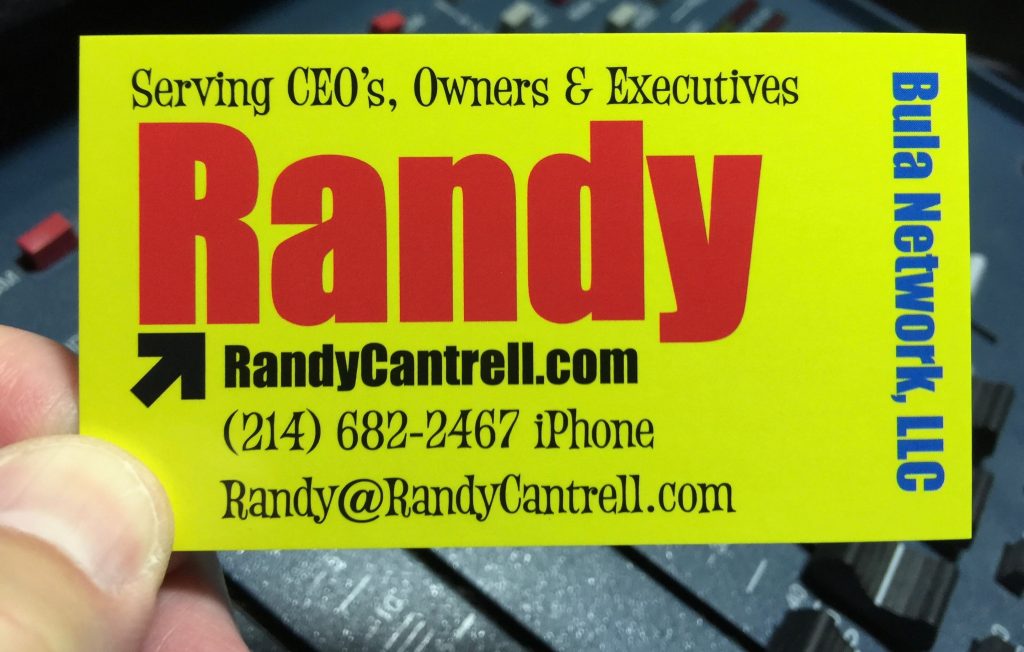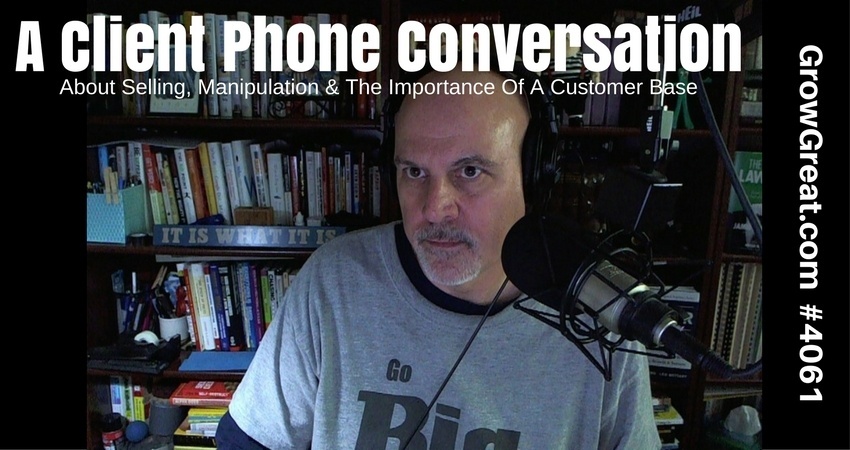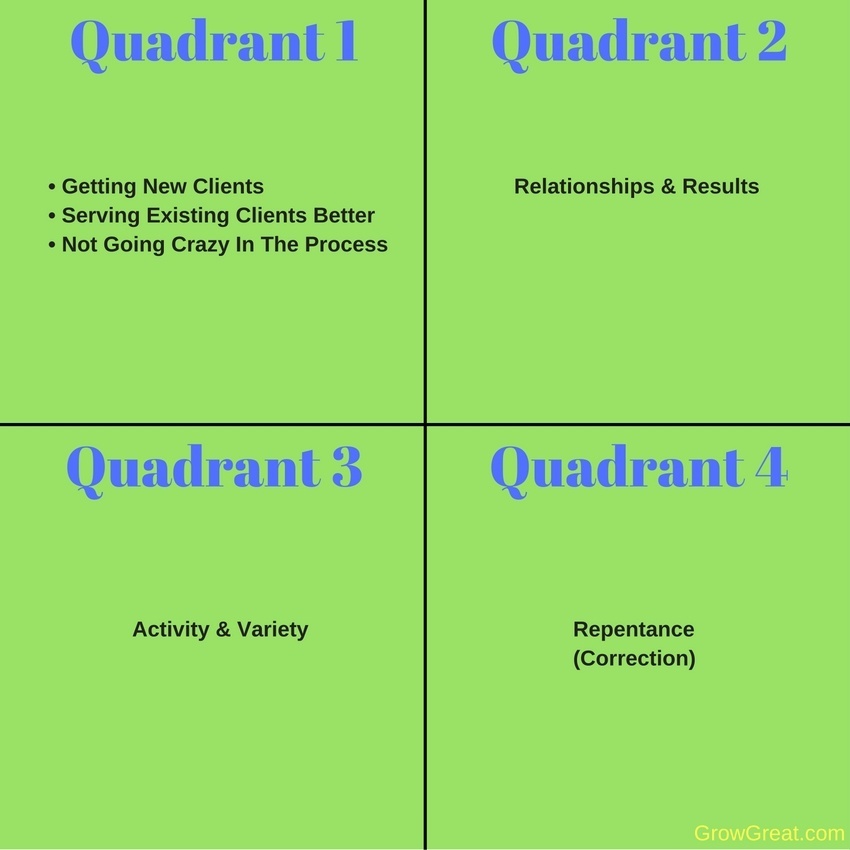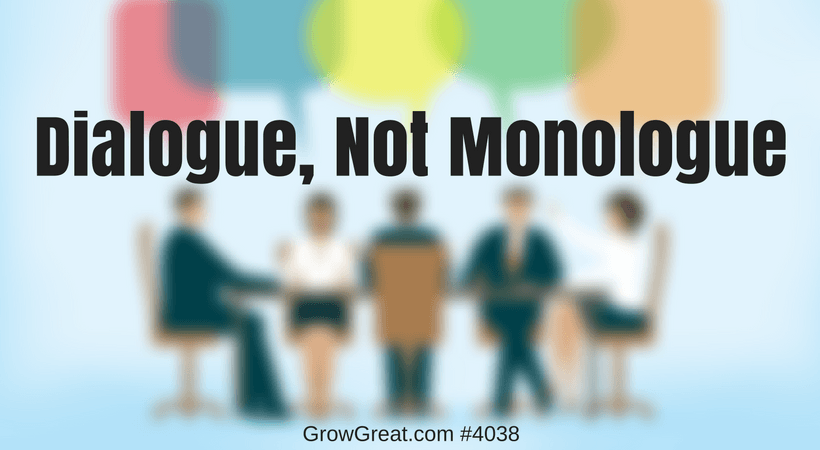Podcast: Play in new window | Download (Duration: 31:10 — 29.1MB)
Subscribe: Apple Podcasts | Spotify | | More
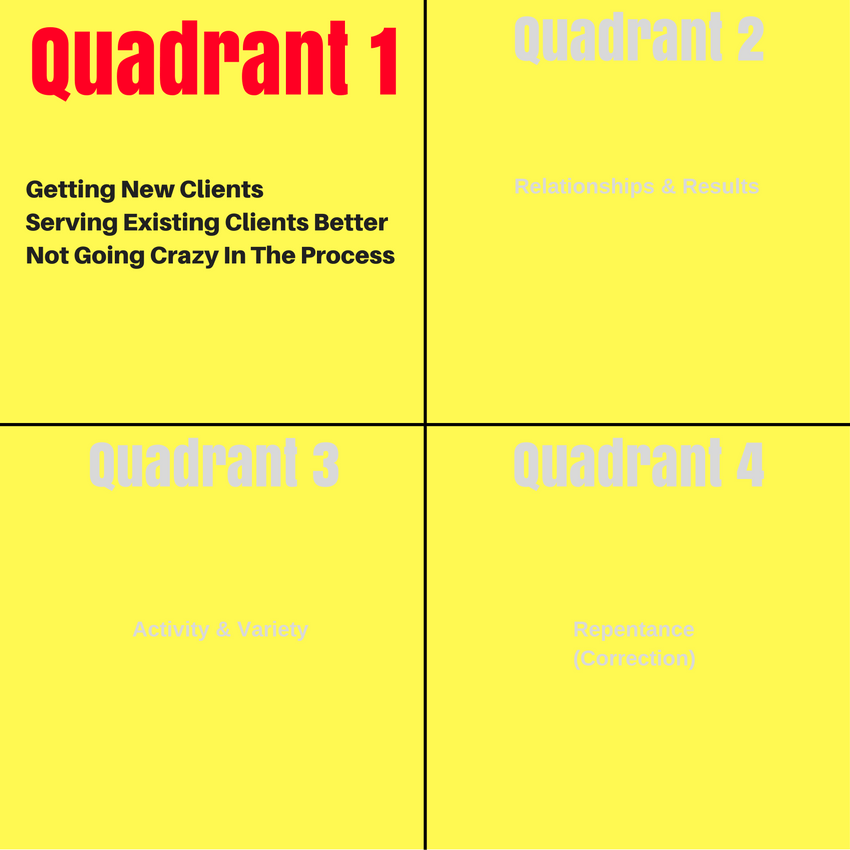
Getting new clients or customers is listed first because until that happens, you don’t have a business. Or an organization. Maybe you don’t call them clients or customers. You might be a non-profit, a local government, or a some other service organization that isn’t directly involved in commerce. No matter…there are people you serve. People who have an expectation of you and your organization. If you don’t serve anybody, then I don’t know why you’d exist. So, first things first.
You Gotta Serve Somebody
Bob Dylan released a song by that title many years ago. It had a religious overtone. Spiritually, service is everything. Namely, serving God. In business, service is also everything. Namely, having a target audience we can serve.
There are 2 critical elements of this. One, we have to take aim at a specific group to serve. These are people who are most benefited by what we have to offer. Two, we have to take aim at a group that is willing to pay for our service (or product). That means they have to see value in what we do.
We can’t get it half right. There are many groups out there who may need what you have. In fact, they might desperately need it. But what if they don’t recognize the need? Or understand the need? No sale. Try as you might, they’ll never buy from you because they don’t know they need what you’ve got.
When you enter quadrant 1 you have to take care to aim at a group that has a need, knows and understands that need, and has the ability to see that you provide a valued solution. Identification is only the beginning. You really need to vet the group by knowing the people. The more, the better.
Marketers latch onto the practice of building an avatar. Of course, avatar is a modern term that started out being called a profile. They mean the same thing. The FBI has profilers who do for crime what marketers do for business. They create a specific profile for the ideal person likely perpetrating the crime. Marketers create a profile for the ideal person likely to buy.
With all the focus on the tactical work of creating a great profile some marketers get too focused on themselves. They approach this work – the work of getting a new customer – without heart. It’s all data and analytical without enough emotion. For good reason. We have more data on buyers than we’ve ever had before. Data is good. The more the better — except when it screams for 100% of the attention without considering the motivations of buyers. Data can have an adverse effect by making marketers focus too much on it and not enough on human emotions like desires, fears, pleasure and pain.
The most ancient marketing truth may be that people buy on emotion and justify it after the fact with logic. It’s a big generalization with varying degrees of accuracy. Some buyers are more emotional than others. Others are far more logical than emotional.
Buyers don’t all come from the same place emotionally, logically, financially or in any other area you can imagine. A buyer without financial concerns, one who has more money than they need, can behave as though they’re on their last nickel. Another buyer with very limited resources can behave as though money is no object. And that is why marketing is hard…and why people and companies pay big money for marketing help.
Marketing is part science and part art. The art part is harder. Anybody can do the science part. It requires heightened intuition, empathy and vision to execute effective marketing. It’s an imperfect craft. Ask anybody who figured out a great marketing strategy that brought in lots of prospects. At some point that brilliant strategy stopped working. Or it stopped working as well. Even Dos Equis replaced “the most interesting man in the world.”
Effective marketing is more like skeet shooting than fixed target shooting.
It’s hard to focus – and keep that focus – on the people you’re trying to serve. You bring your own motivations. They include your desires, fears, pains and pleasures. But your prospects and buyers don’t care about yours. They’ve got their own. It requires a special kind of discipline to get out of your own head and into the head of prospects. Then, to stay there.
The psychology of marketing – attracting new clients – is dynamic. Look at your own life. I know it sometimes feels like you’re living a real-life version of Groundhog Day, but you aren’t. Your moods and feelings ebb and flow. Along with your optimism and fears. Life impacts all of us every single day. Your prospects live the same way. Some days you eat the bear, some days the bear eats you. That old phrase just speaks to the bi-polar nature of all our lives.
That also speaks to why our marketing can never stop. You never know the timing of your offer. Right now – at this very moment – let’s assume the tires on your car are perfect. You’re not thinking about tires. Any marketing by tire retailers or manufacturers is going right over your head. Later today, you’re on the freeway and have a blow out. It wrecks your day, hacks you off. But suddenly, you’re now in the market for a tire – maybe a whole set. It happened suddenly, unexpectedly. If there’s a tire retailer who has achieved some top of mind status with you through their persistent and consistent marketing, then they’re likely to be your first call. Maybe your only call.
Buyers buy on their timetable, not yours. Your need for a sale doesn’t matter. It’s all about what your prospect wants and needs. And like skeet shooting, you don’t know where they’re at…at the very moment they need you the most. When they’re ready to buy, they’re ready to buy. Or at least ready to consider buying.
Do you attract clients by focusing on their pain or pleasure? Do you pander to their fears or their hopes? Yes. And yes. That’s why marketing is hard. You have to create messages that appeal to your ideal prospects. Ideal is optimal. It doesn’t mean you won’t sell to some prospects who aren’t ideal. Think of it like fishing for large mouth bass. That’s ideal. It’s the aim. But if you snag a 10 pound catfish…you’re going to eat him for supper. You weren’t trying to land him, but he liked your offer and took it. You decided to keep him. At the other end of the deal, you could snag a carp. You don’t want him. He goes back into the water. That’s how marketing works. Sometimes you get a happy accident – a client you weren’t really aiming at, but you attracted them anyway. You keep them. Sometimes you get a not-so-happy accident – a client you weren’t aiming at, and one you’d rather not have. You walk away (hint: maybe it’s ideal for you to best serve them by finding them a more suitable solution).
So how do we get new customers?
It’s not difficult to dissect the process. Execution…that’s what’s really hard.
Identify your ideal customer. Dig deep and figure out the emotions, not just the data points. Part of identification is figuring how where they are and how to best reach them. Again, not always easy. And it’s not always where you may first think. Spend some time on this. It’s important.
Craft your offer with the client in mind. Sure, it may be best to craft an offer people want. You hear it constantly with online advice. “Give your customers what they ask for.” But what if you don’t yet have customers? Or what if you’re unhappy with the present flow of customers? What do you do when your customers don’t even know what they want? (Apple invested the iPod. Customers weren’t asking for it. Most consumers couldn’t imagine carrying around hours of music on a small digital device.)
Customers are created when you can find the sweet spot of what people want/need enough that they’ll pay for it. And pay enough to make it sustainable. Would more people buy Apple products if they were 30% cheaper? Sure, but it would wreck Apple’s profit margin and Apple would stop being the highly sophisticated design company they are. In short, Apple wouldn’t be Apple.
It’s a lot of hard work best summed up in the phrase, “figuring it out.” Whether you’re a stand up comedian or a manufacturer…you need paying customers. Financial support is the most critical component of successful business building. No customers, no business. No revenue, no business. This is no time for weepy romanticism. It’s time for facing the practical realities of the market, that collective power that will determine the winners and the losers.
Once you get them to buy the real work begins.
Now, you must deliver. Well, to be clear, if you’re operating with integrity you must deliver. Thanks to the power of the Internet we see people and companies who devote all their time to “top of the funnel” activities. They focus solely on getting new customers. These are transactional focused marketers who don’t care so much about the customer experience. Or about repeat business. Some pursue as much revenue generation as possible to exploit a moment, knowing it will go cold. It’s that old adage of “making hay while the sun shines.” The sun sometimes shines and may give us a “Pet Rock” moment. It doesn’t last, but it’s good while it does. I’m not talking about that kind of business model.
My clients – and hopefully yours – are people and companies we want to serve well. We want them to be happy, not merely satisfied with our work for them. We want them to say good things about us. We want their repeat business and we’d like them to give us referrals. In short, we want to build the strongest customer base possible. So we focus heavily on serving our clients better. This is mostly, but not entirely an operational thing. It’s the HOW we do things.
Too frequently I see companies get this wrong because they can’t (or won’t) maintain focus on the client. Systems and work flows are put into place because they best serve US, not because they enhance the client’s experience. Perhaps the most classic example of this is the airline industry. While there are government regulations in play, an awful lot of what happens with flyers has little or nothing to do with regulations, but everything to do with how the airline is benefited. Often times at the expense of their paying customers. It’s so rampantly bad, customers have been conditioned and trained to accept poor service as standard. We don’t want to follow their example.
Amazon has become the poster child for superior service – not by accident, but by design. Millions of dollars are spent each year by Amazon finding out how customers respond, how customers behave, what customers prefer and delivering an experience that has come to be so utterly painless (and pleasurable) they can consistently produce double digit increases in revenues (year over year). That’s no small feat when you’re a multi-billion dollar company. It’s easy to double your business if you’re generating $250,00 in gross revenue (maybe). Not so easy when your existing number is insanely large, like Amazon.
How do they do it? By being focused on YOU, the buyer. Your shopping and buying experience at Amazon is easy. Who started the “one click” purchase? Amazon. I rest my case.
How easy are you to do business with? Do you focus on how the customer feels and perceives the process? Or do you focus on making it easy on yourself?
I’m betting if you took a hard look at your systems and processes you’d find some (perhaps many) of them cumbersome to the customer. Stop it. Remove the hurdles from the path of your customers. Make your company easy to do business with. Make the experience not just pain-free, but pleasurable for the customer.
Crazy.
It’s not just a song by Patsy Cline and Gnarls Barkley (yeah, different songs…same title). It’s YOU when things aren’t going so well. It’s YOU when getting new clients isn’t happening, or when existing clients are complaining. It’s also YOU when things at home aren’t right (nothing to do with business). Welcome to the Human Race where problems and obstacles pop up like a whack-a-mole game!
Keeping your sanity is a big part of effective business building. Watch an NFL game, especially this time of year when playoff positions are at stake. It won’t matter if it’s a quarterback or some other position, from the most regarded position to the least regarded, you may see a player – keep in mind, all these guys are world-class or they wouldn’t be playing – lose his mind. Sideline fits get pitched. Helmets get thrown. Water trays get knocked over. All because world-class, professional athletes have, in a moment, lost their mind.
In that state, are they able to perform at their best? NO. Never. They have to rein in their emotions. They have to get a better gripe on themselves. Some do. Some don’t. Those who don’t, end up making things worse. Those who do, often aren’t able – at least in that game – to make meaningful contributions. The distraction of going crazy took a toll robbing them of the chance for success. It’ll happen to you, too.
For you it may not look like a temper tantrum. Or it may.
Maybe it’s just a funk. Caused by something at work. Or not. No matter, you’re in a mood. Preoccupied. Worried. Fretful. Anxious. Sad. Gloomy. Attach whatever word that best describes it at the time. And these aren’t binary things. Every color of the rainbow can happen. Today’s purple is tomorrow’s red. So it goes with our feelings and emotions. Crazy.
Crazy isn’t a clinical diagnosis. It’s purely man-on-the-street kind of talk. We all experience it at various times. It’s not a state from which growth can occur, but it is a state from which our response can spur growth. How we respond to our own crazy matters.
First, we have to recognize it and understand the source. No proper response can be executed if we don’t understand why we’re going crazy.
Second, we have to craft the best response to the source. Address the cause – the source – and you’ll likely remedy the manifestation of your crazy. Now if you’re hot headed, stop it. You need to exercise better self-control. Your bad temper is completely preventable and I don’t care what you think the cause it, it’s a problem. Blowing up isn’t a valid or valuable response, even if you do think it’s justified. You’re wrong. Pitching a wall-eyed fit every time something goes wrong isn’t leadership. It’s childish and will cost you. Well placed anger on the other hand, used in proper context (even for theatrical purposes) can be most effective. One is mindless. The other is mindful. There’s a big difference!
Get in full touch with the source of your craziness. Figure out what you can do to alter your response to it. Maybe it’s something you have no power over – the source, that is. Fine, figure out the best methodology of dealing with it. Harold Geneen said, “Managers must manage.” Figure it out. Find a way.
Third, learn from it. Stop being reactionary with knee-jerk emotional responses. Sure, it happens. But don’t let that define your leadership. Make those exceptions to the rule of being level-headed and thoughtful.
My desire for you – just like all my clients – is to help you keep all three legs on the floor at all times. It’s almost impossible to do, but you should try. When all three legs are solidly on the floor, you’ve got major traction and success. When one legs comes up off the floor, recognize it quickly. One inch off the floor is very different than six inches. Catch it early and try to course correct by getting it back on the ground as soon as possible.
When two legs come off the floor you’re in trouble. Don’t panic, but get one of them on the ground fast. Business building is about maintaining stability. Don’t over-complicate things. Address things. Face them. Deal with them in positive ways. Work harder to fix what ails you so you can move on beyond old, recurring problems.
The most you can keep these 3 legs on the floor, the greater your traction – and the greater your odds are building something great. And that’s our goal. To grow great!
Happy Holidays!

Subscribe to the podcast
 To subscribe, please use the links below:
To subscribe, please use the links below:
If you have a chance, please leave me an honest rating and review on iTunes by clicking Review on iTunes. It’ll help the show rank better in iTunes.
Thank you!

 To subscribe, please use the links below:
To subscribe, please use the links below: